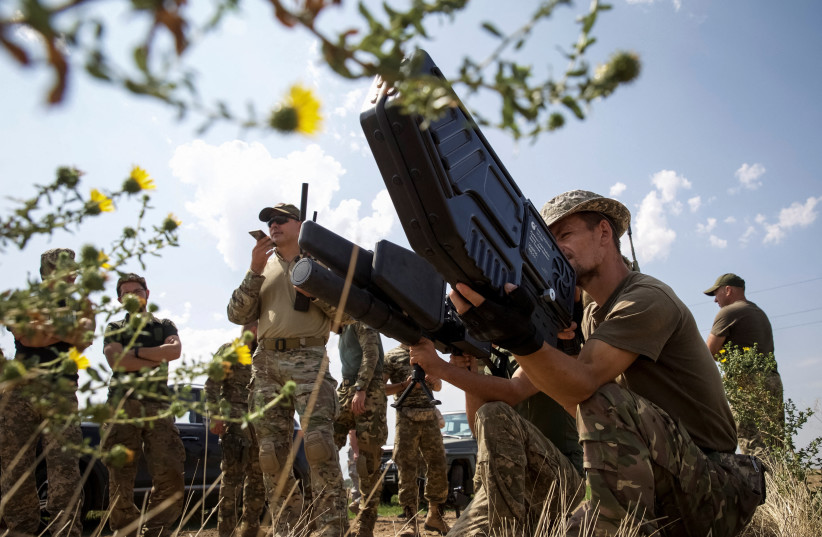Iran’s latest drone capabilities, documented in photos from a recent Iranian drone exercise, were captured by Iran’s Fars News and a Ukrainian website named Defense Express. The Ukrainian report alleges that Iran has copied Israel’s Spike anti-tank missile and installed it on a drone.
And this isn’t new. Iran has increased the capabilities of its drones in recent years. Some of the claims Iran makes about its drones’ capabilities cannot be substantiated and it is not always clear how well the machines really perform. On the other hand, it is clear that Iranian drones are being increasingly used in the region by militant and terrorist groups and that Iran is exporting drones to Africa, South America and Central Asia.
Recent reports even pointed to possible Iranian drone technology transfers to Russia.
The Ukrainian report specifies the Iranian Mohajer-6 drone, how it has been equipped with “anti-tank missiles and guided aerial bombs,” and discusses what kinds of threats Iranian unmanned aerial vehicles (UAVs) can now muster.
Why is a Ukrainian site reporting on Iranian drones?

The Ukrainian interest in this issue could be purely a military analysis since the website is interested in defense issues, but there may be more here as well.
Ukraine has used armed drones to try to slow the advance of the Russian military throughout the six-month war. Ukraine has used American and Turkish drones, as well as locally developed drones.
Ukraine has an interest in knowing whether Iranian drones might be exported to Russia. The Mohajer line of drones is an export model, so Iran’s ability to install missiles on it is an important development that would capture Ukrainian attention.

“It is currently unknown whether the Russian Federation will buy these UAVs; however, the other day, high-quality photos of weapons under the wings of this and other UAVs ‘lit up’ on the Internet, which gives reason to talk about them,” read the report.
It added that photos from the recent Iranian drone exhibition drill show an “Almas anti-tank guided missile under the wing of an Israeli Mohajer-6 drone. The Iranian ATGM with this guided missile was introduced in July 2021. In fact, Almas is a copy of the Israeli Spike, the missile received a hi-tech homing head and a warhead, the declared range of this missile is up to 8,000 meters.”
What other drones were at this drill?
The drill also showcased a drone called Kaman-12 which Iran claims can fly at a speed of 200 kph (125 mph) and remain airborne for 10 hours with a range of some 2,000 km (1,245 miles).
Iran also showcased its Qaem bomb, a weapon that it claims is laser-guided and has infrared homing. Images showed the operators watching a screen with the bomb heading toward a target. The reports say these were Qaem 5 and Qaem 9 bombs.
“The stated range of hitting the targets of these aerial bombs is 15-20 km. depending on the altitude of the UAV flight,” the report says.
“The stated range of hitting the targets of these aerial bombs is 15-20 km depending on the altitude of the UAV flight.”
Ukrainian media outlet Defense Express
What about the Iranian report?
Iran's Fars News reported on the Ukrainian report – practically word-for-word – with the headline, “What weapons do Iranian drones carry?”
This is sort of an ironic question for Iranian media to ask since it is the Iranian government and state media, such as IRNA, which have been publishing Iranian propaganda photos of the drones and their alleged capabilities. Iranian media is trying to launder foreign reports to legitimate their own government claims.
The idea here is to point to the foreign report as “confirming” the capabilities, even though no one can substantiate the capabilities independently. Iran does export the Mohajer line of drones to places like Venezuela and Ethiopia, yet it is unclear how well the drones perform.
Overall, the Iranian goal here is to show that their drones have the same kinds of capabilities as American, Israeli, Turkish or other armed drones. Putting anti-tank missiles and long-range bombs on the drones would seem to give Iran a new capability, but it is unclear how much evidence there is that these drones actually work, that they can really fly the long distances Iran claims, and that they can deploy missiles and bombs.
There are many issues involved in using drones at a long range and launching missiles and bombs from them. It requires an operator to be in the loop during the drone’s flight, which necessitates having ways to communicate with the drones.
It is unclear if Iran can do this when its drones are so far away from the country, or from Iranian operatives in places like Syria, Iraq, Lebanon or Yemen. Iran, in the past, has programmed drones to fly via waypoints and then kamikaze into the target.
Last year, Iran also used drones to target the bridge of a moving ship in the Gulf of Oman, showcasing its increased capabilities to command and control the drones during the attack.
Many Iranian drone models are copies of foreign drones or build on the successes of foreign drones. For instance, Iranian drone models often appear to try to copy other drones, such as the US Predator or Reaper, or the Israeli Heron, Eitan and Hermes drones.
The times Iranian drones have been more successful can be credited to Iran making them as cheap and expendable as kamikaze drones. It has sent the technology for these more simple drones to Yemen, Iraq, Syria and Lebanon, and even Gaza.
Iran’s success with the Mohajer 6 and other larger drones, and putting missiles on them, is still a major hurdle for Tehran, especially if it wants to export them in the future.
Iran has learned from Turkey’s success exporting the Bayraktar that it needs a consistent platform that can be armed. For that reason, it wants its capabilities to be publicized in foreign reports.
